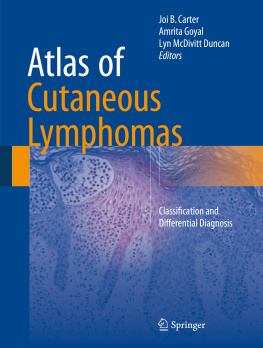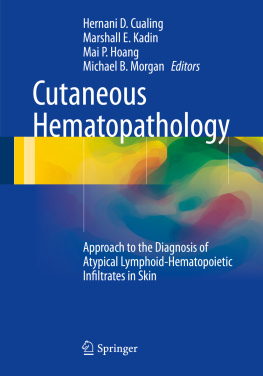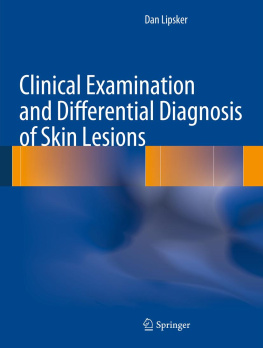Springer International Publishing Switzerland 2015
Joi B. Carter , Amrita Goyal and Lyn McDivitt Duncan (eds.) Atlas of Cutaneous Lymphomas 10.1007/978-3-319-17217-0_1
1. Introduction and a Brief History of Cutaneous Lymphoma Classification
Over the past decade, a worldwide consortium of dermatologists, oncologists, hematopathologists, and dermatopathologists has collaborated to develop a unified classification scheme for lymphomas, including primary cutaneous lymphomas. Every year, new publications and workshops lead to a clearer understanding of the nuances of diagnosis and treatment of cutaneous lymphomas. Over the past 20 years, advances in the classification of cutaneous lymphomas have revolutionized the clinical and histopathologic approaches to diagnosis and treatment of these highly varied diseases. This chapter outlines some aims of this book and offers a brief history of cutaneous lymphoma classification.
1.1 Goals of This Book
Understanding cutaneous lymphoma can be challenging for even the most determined, for several reasons:
Some of these diseases share clinical presentations.
Some display similar histopathological features.
While immunophenotypic and genetic features may support a specific diagnosis, there is overlap between tumors.
The terminology used to describe these tumors has evolved and only in the past decade has there been a more uniform approach to classification.
Few textbooks offer concise descriptions of the clinical and histopathologic characteristics of these diseases in accordance with the most recent classification system. This atlas seeks to fill that gap.
This book was written with several goals in mind:
Assemble an atlas of cutaneous lymphomas, organized according to the most recent classification system, as designed by the World Health OrganizationEuropean Organization for Research and Treatment of Cancer (WHO-EORTC)
Offer flowcharts and other schemas to help organize the cutaneous lymphomas in an easy to understand format
Provide a concise summary of current knowledge about the clinical presentation, histopathological, immunophenotypic and genetic characteristics, prognosis, and treatment of each cutaneous lymphoma
Demonstrate the importance of clinicalpathologic correlation using real clinical cases, in most cases by juxtaposing both the clinical and histopathologic images from the same patients
Present this information at a level appropriate for students, trainees, and practitioners in dermatology and pathology.
1.2 History of the Classification of Cutaneous Lymphomas
For more than a century and a half, lymphomas arising in the skin were classified as one of three entities: mycosis fungoides, Szary syndrome, or spread of lymphoma from a noncutaneous site. Although mycosis fungoides was first described by Alibert [], it was not until the 1970s that primary cutaneous lymphomas other than mycosis fungoides and Szary syndrome were differentiated from cutaneous manifestations of systemic lymphoma. At that time a classification system reflecting the heterogeneity of cutaneous lymphomas began to be developed.
At the end of the last century, it became increasingly clear that a wide range of B-cell and T-cell lymphomas can occur as primary tumors in the skin, and that they have quite variable clinical outcomes: some primary cutaneous lymphomas are indolent and never disseminate to extracutaneous sites, while others disseminate widely with an aggressive clinical course. This variability in clinical outcome is one of the primary reasons that an accurate classification system is necessary.
From the 1970s to the 1990s, there were three principal classification schemes for lymphomas: Kiel []. In addition to the features used in the REAL classification scheme, the EORTC scheme incorporated the clinical presentation and biologic behavior of the lymphomas.
In 2001, the World Health Organization (WHO) International Agency for Research and Cancer published The Pathology and Genetics of Tumours of Haematopoietic and Lymphoid Tissues , 3rd edition [].
In 2008, the 4th edition of the WHO Classification of Tumours of Haematopoetic and Lymphoid Tissues was published. This volume, the blue book, integrated the primary cutaneous lymphoma classification into the broader classification of nodal and other extranodal lymphoma classification []. The integrated EORTC and WHO classification has become the basis for diagnosis and treatment of patients with cutaneous lymphomas. Persistent inconsistencies between the WHO/EORTC (2005) and WHO (2008) classifications include the use of the terms, primary cutaneous marginal zone lymphoma and CD4+ CD56+ hematodermic neoplasm, in the former and the terms extranodal marginal zone lymphoma of mucosa-associated lymphoid tissue (MALT lymphoma) and blastic plasmacytoid dendritic cell neoplasm in the latter. Because the WHO classification found in the blue book encompasses all leukemias and lymphomas, it can be cumbersome and challenging for dermatologists and dermatopathologists to dissect out the information on skin-specific diseases. Our aim is to provide a resource for diagnosis of primary cutaneous lymphomas that includes clinical and histopathological images of the diseases described in accordance with the most recent classification scheme. We refer to the classification as WHO-EORTC to recognize the important contributions of both of these groups.
1.3 Terminology
The field of cutaneous lymphomas is rife with terminological ambiguity. For example, the term primary cutaneous is itself controversial. It has been used by some to describe lymphoma arising in the skin without evidence of concurrent extra-cutaneous lymphoma after staging (often including both radiological and bone marrow evaluation) [].
The majority of lymphomas are named descriptively after their cell of origin. For example, primary cutaneous follicle centre lymphoma (pcFCL) is a tumor composed of neoplastic BCL-6+ follicle center B cells. This biologically based, descriptive naming system carries two complications. First, names of the lymphomas are changed as new biological information is discovered. For example, what was once CD4+ CD56+ hematodermic neoplasm is now called blastic plasmacytoid dendritic cell neoplasm, because of better understanding of the cell of origin of the disease. A better understanding of the risk of progression has led some disease entities to be divided and re-defined; for example the Ketron-Goodman variant of pagetoid reticulosis is now considered to be best classified as either aggressive epidermotropic CD8+ cutaneous T-cell lymphoma or cutaneous gamma-delta T-cell lymphoma, depending on the immunophenotype. Second, given the descriptive terminology, the names of these diseases can be up to seven to eight words long, as with primary cutaneous CD4+ small-medium pleomorphic T-cell lymphoma. One student even suggested that cutaneous lymphoma may be the one case in which eponymous naming might actually make things easier . There has even been discord over these extensive descriptive names. For example, while some prefer extranodal marginal zone B-cell lymphoma of mucosa-associated lymphoid tissue (MALT lymphoma), others use the term primary cutaneous marginal zone lymphoma (pcMZL). The use of the term extranodal indicates that this tumor is biologically related to those occurring at other extranodal sites (most commonly the gastrointestinal tract); however, some argue that the use of MALT is inappropriate given that the skin is not mucosa.











